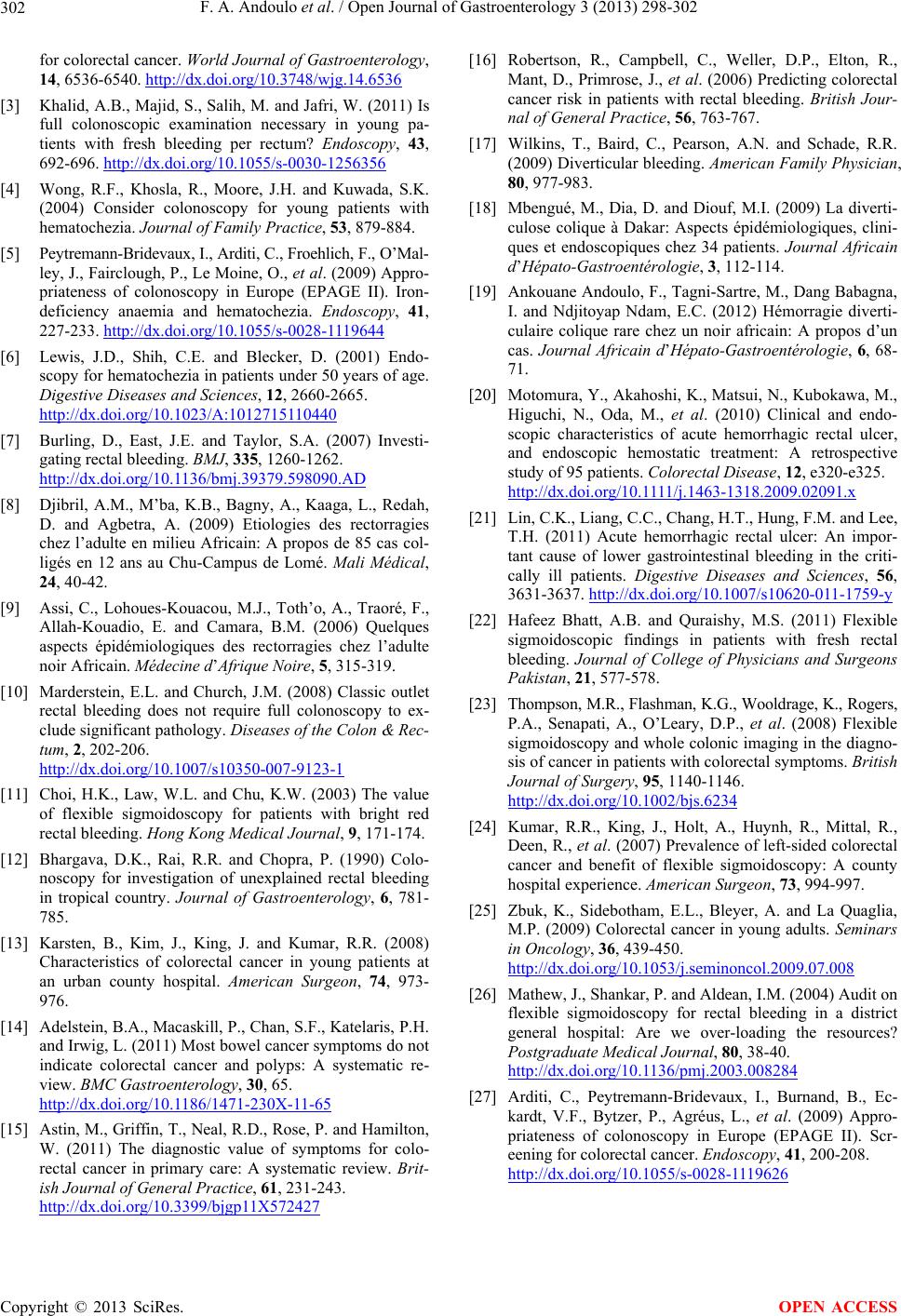
F. A. Andoulo et al. / Open Journal of Gastroenterology 3 (2013) 298-302
Copyright © 2013 SciRes.
302
OPEN ACCESS
for colorectal cancer. World Journal of Gastroenterology,
14, 6536-6540. http://dx.doi.org/10.3748/wjg.14.6536
[3] Khalid, A.B., Majid, S., Salih, M. and Jafri, W. (2011) Is
full colonoscopic examination necessary in young pa-
tients with fresh bleeding per rectum? Endoscopy, 43,
692-696. http://dx.doi.org/10.1055/s-0030-1256356
[4] Wong, R.F., Khosla, R., Moore, J.H. and Kuwada, S.K.
(2004) Consider colonoscopy for young patients with
hematochezia. Journal of Family Practice, 53, 879-884.
[5] Peytremann-Bridevaux, I., Arditi, C., Froehlich, F., O’Mal-
ley, J., Fairclough, P., Le Moine, O., et al. (2009) Appro-
priateness of colonoscopy in Europe (EPAGE II). Iron-
deficiency anaemia and hematochezia. Endoscopy, 41,
227-233. http://dx.doi.org/10.1055/s-0028-1119644
[6] Lewis, J.D., Shih, C.E. and Blecker, D. (2001) Endo-
scopy for hematochezia in patients under 50 years of age.
Digestive Diseases and Sciences, 12, 2660-2665.
http://dx.doi.org/10.1023/A:1012715110440
[7] Burling, D., East, J.E. and Taylor, S.A. (2007) Investi-
gating rectal bleeding. BMJ, 335, 1260-1262.
http://dx.doi.org/10.1136/bmj.39379.598090.AD
[8] Djibril, A.M., M’ba, K.B., Bagny, A., Kaaga, L., Redah,
D. and Agbetra, A. (2009) Etiologies des rectorragies
chez l’adulte en milieu Africain: A propos de 85 cas col-
ligés en 12 ans au Chu-Campus de Lomé. Mali Médical,
24, 40-42.
[9] Assi, C., Lohoues-Kouacou, M.J., Toth’o, A., Traoré, F.,
Allah-Kouadio, E. and Camara, B.M. (2006) Quelques
aspects épidémiologiques des rectorragies chez l’adulte
noir Africain. Médecine d’Afrique Noire, 5, 315-319.
[10] Marderstein, E.L. and Church, J.M. (2008) Classic outlet
rectal bleeding does not require full colonoscopy to ex-
clude significant pathology. Diseases of the Colon & Rec-
tum, 2, 202-206.
http://dx.doi.org/10.1007/s10350-007-9123-1
[11] Choi, H.K., Law, W.L. and Chu, K.W. (2003) The value
of flexible sigmoidoscopy for patients with bright red
rectal bleeding. Hong Kong Medical Journal, 9, 171-174.
[12] Bhargava, D.K., Rai, R.R. and Chopra, P. (1990) Colo-
noscopy for investigation of unexplained rectal bleeding
in tropical country. Journal of Gastroenterology, 6, 781-
785.
[13] Karsten, B., Kim, J., King, J. and Kumar, R.R. (2008)
Characteristics of colorectal cancer in young patients at
an urban county hospital. American Surgeon, 74, 973-
976.
[14] Adelstein, B.A., Macaskill, P., Chan, S.F., Katelaris, P.H.
and Irwig, L. (2011) Most bowel cancer symptoms do not
indicate colorectal cancer and polyps: A systematic re-
view. BMC Gastroenterology, 30, 65.
http://dx.doi.org/10.1186/1471-230X-11-65
[15] Astin, M., Griffin, T., Neal, R.D., Rose, P. and Hamilton,
W. (2011) The diagnostic value of symptoms for colo-
rectal cancer in primary care: A systematic review. Brit-
ish Journal of General Practice, 61, 231-243.
http://dx.doi.org/10.3399/bjgp11X572427
[16] Robertson, R., Campbell, C., Weller, D.P., Elton, R.,
Mant, D., Primrose, J., et al. (2006) Predicting colorectal
cancer risk in patients with rectal bleeding. British Jour-
nal of General Practice, 56, 763-767.
[17] Wilkins, T., Baird, C., Pearson, A.N. and Schade, R.R.
(2009) Diverticular bleeding. American Family Physician,
80, 977-983.
[18] Mbengué, M., Dia, D. and Diouf, M.I. (2009) La diverti-
culose colique à Dakar: Aspects épidémiologiques, clini-
ques et endoscopiques chez 34 patients. Journal Africain
d’Hépato-Gastroentérologie, 3, 112-114.
[19] Ankouane Andoulo, F., Tagni-Sartre, M., Dang Babagna,
I. and Ndjitoyap Ndam, E.C. (2012) Hémorragie diverti-
culaire colique rare chez un noir africain: A propos d’un
cas. Journal Africain d’Hépato-Gastroentérologie, 6, 68-
71.
[20] Motomura, Y., Akahoshi, K., Matsui, N., Kubokawa, M.,
Higuchi, N., Oda, M., et al. (2010) Clinical and endo-
scopic characteristics of acute hemorrhagic rectal ulcer,
and endoscopic hemostatic treatment: A retrospective
study of 95 patients. Colorectal Disease, 12, e320-e325.
http://dx.doi.org/10.1111/j.1463-1318.2009.02091.x
[21] Lin, C.K., Liang, C.C., Chang, H.T., Hung, F.M. and Lee,
T.H. (2011) Acute hemorrhagic rectal ulcer: An impor-
tant cause of lower gastrointestinal bleeding in the criti-
cally ill patients. Digestive Diseases and Sciences, 56,
3631-3637. http://dx.doi.org/10.1007/s10620-011-1759-y
[22] Hafeez Bhatt, A.B. and Quraishy, M.S. (2011) Flexible
sigmoidoscopic findings in patients with fresh rectal
bleeding. Journal of College of Physicians and Surgeons
Pakistan, 21, 577-578.
[23] Thompson, M.R., Flashman, K.G., Wooldrage, K., Rogers,
P.A., Senapati, A., O’Leary, D.P., et al. (2008) Flexible
sigmoidoscopy and whole colonic imaging in the diagno-
sis of cancer in patients with colorectal symptoms. British
Journal of Surgery, 95, 1140-1146.
http://dx.doi.org/10.1002/bjs.6234
[24] Kumar, R.R., King, J., Holt, A., Huynh, R., Mittal, R.,
Deen, R., et al. (2007) Prevalence of left-sided colorectal
cancer and benefit of flexible sigmoidoscopy: A county
hospital experience. American Surgeon, 73, 994-997.
[25] Zbuk, K., Sidebotham, E.L., Bleyer, A. and La Quaglia,
M.P. (2009) Colorectal cancer in young adults. Seminars
in Oncology, 36, 439-450.
http://dx.doi.org/10.1053/j.seminoncol.2009.07.008
[26] Mathew, J., Shankar, P. and Aldean, I.M. (2004) Audit on
flexible sigmoidoscopy for rectal bleeding in a district
general hospital: Are we over-loading the resources?
Postgraduate Medical Journal, 80, 38-40.
http://dx.doi.org/10.1136/pmj.2003.008284
[27] Arditi, C., Peytremann-Bridevaux, I., Burnand, B., Ec-
kardt, V.F., Bytzer, P., Agréus, L., et al. (2009) Appro-
priateness of colonoscopy in Europe (EPAGE II). Scr-
eening for colorectal cancer. Endoscopy, 41, 200-208.
http://dx.doi.org/10.1055/s-0028-1119626